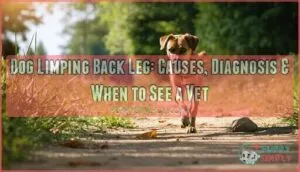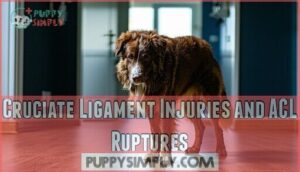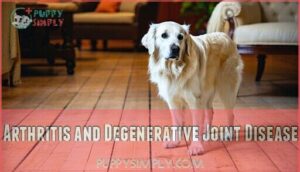This site is supported by our readers. We may earn a commission, at no cost to you, if you purchase through links.
 A dog limping on a back leg can stem from anything—a simple muscle strain that’ll heal with rest, a torn ACL demanding surgery, or arthritis creeping in as your dog ages. The key is knowing what you’re looking at: sudden limping after a fall points to trauma, while gradual reluctance to jump suggests joint degeneration.
A dog limping on a back leg can stem from anything—a simple muscle strain that’ll heal with rest, a torn ACL demanding surgery, or arthritis creeping in as your dog ages. The key is knowing what you’re looking at: sudden limping after a fall points to trauma, while gradual reluctance to jump suggests joint degeneration.
Watch for red flags like swelling, refusal to bear weight, or signs of severe pain—these warrant immediate veterinary care, not a wait-and-see approach. Understanding whether you’re dealing with an acute injury or chronic condition shapes everything from your next steps to long-term management.
Table Of Contents
- Key Takeaways
- Why is My Dog Limping on a Back Leg?
- How Do I Know if It’s an Emergency?
- What Are The Most Common Causes?
- How Will a Vet Diagnose Back Leg Limping?
- What Can I Do to Help at Home?
- What Are The Treatment and Recovery Options?
- How Can I Prevent Future Leg Injuries?
- Frequently Asked Questions (FAQs)
- What are the different types of limping in dogs?
- What are the causes of hind leg weakness in dogs?
- What are the treatment options for arthritis in dogs?
- Can limping spread to both back legs over time?
- What home exercises help dogs with mild limping?
- Can diet changes reduce limping in my dog?
- How long before limping becomes permanent without treatment?
- Conclusion
Key Takeaways
- Limping divides into sudden-onset injuries (ACL tears, fractures, trauma) and gradual chronic conditions (arthritis, degenerative joint disease), with large breeds facing higher risks for cruciate ligament ruptures and bone cancer while small breeds deal with patellar luxation and spinal disc issues.
- Emergency signs requiring immediate veterinary care include refusal to bear weight, visible swelling, extreme pain with vocalization, collapse, or inability to stand, while mild intermittent limping that improves with rest can be monitored at home before scheduling a regular vet appointment.
- Diagnosis combines your observations about onset and activity with physical examination, gait analysis, and imaging studies (X-rays detect 95% of fractures, though MRI or CT scans are needed for soft tissue injuries), with treatment ranging from rest and NSAIDs for minor strains to surgical repair costing $1,500-$6,000 for severe ligament tears.
- Prevention focuses on maintaining a healthy weight (every extra pound stresses compromised joints), providing joint supplements with omega-3 fatty acids and glucosamine, and catching subtle mobility changes early through daily monitoring of gait, stiffness after rest, and reluctance to jump or climb stairs.
Why is My Dog Limping on a Back Leg?
Your dog’s back leg limp might be a simple strain that clears up in a day or two, or it could signal something more serious that needs a vet’s attention right away.
How quickly the limp showed up—sudden or gradual—plus your dog’s age and breed, all point you toward whether this needs a vet visit now or can wait a bit.
Common Causes of Sudden Limping
When your dog suddenly won’t bear weight on a back leg, the culprit is usually one of a few common suspects that can strike without warning. Trauma injuries from slips or falls, muscle strains from overexertion, and ACL tears top the list.
Soft tissue damage, bone fractures, and ligament ruptures can also cause immediate limping. These dog leg injuries demand prompt attention—catching them early improves your dog’s prognosis markedly.
Gradual Onset Lameness in Older Dogs
As your dog ages, you might notice that getting up from a nap takes a little longer, or that the usual sprint to the food bowl has turned into a cautious, stiff-legged walk. These subtle changes often signal the slow march of degenerative joint disease rather than a sudden injury.
Canine arthritis usually worsens over weeks or months, making your senior dog reluctant to climb stairs or jump onto furniture. You’ll want veterinary care to slow progression and keep your aging dog comfortable through geriatric rehabilitation and joint-supportive treatments.
Breed and Age Predispositions
Your dog’s genes have a big impact on their health, especially when it comes to back leg limping. Breed type and size can really change the kinds of vet issues your dog might face.
- Large breeds like Rottweilers, Labrador Retrievers, and German Shepherds face higher odds of cruciate ligament ruptures, hip dysplasia, and bone cancer—with some breeds showing up to 26 times greater osteosarcoma risk.
- Small and chondrodystrophic breeds such as Dachshunds have lower bone cancer rates but deal with unique issues like patellar luxation and IVDD.
- Age risks peak between 5–10 years for ligament injuries, while geriatric dogs over 10 experience arthritis at five times the rate of younger adults.
- Neutering before six months increases hip dysplasia and ligament injury susceptibility across multiple breeds, highlighting timing considerations in preventive dog health issues.
Understanding bone cancer risks is vital for dog owners to take preventive measures.
Injury Vs. Chronic Conditions
Understanding the difference between a sudden injury and a slowly developing chronic condition can mean the difference between a quick fix and months of careful management. Acute injuries—like ACL rupture or muscle strain—usually show up overnight with dramatic limping.
Chronic pain from degenerative diseases like arthritis builds gradually, requiring ongoing rehabilitation techniques rather than surgical options alone. Recognizing this distinction helps you pursue the right canine injury prevention strategies moving forward.
How Do I Know if It’s an Emergency?
Not every limp means you need to race to the emergency vet, but some warning signs shouldn’t wait.
You’ll want to spot the red flags that point to serious injury—and know what can hold until your regular appointment.
Signs of Severe Pain or Distress
When your dog suddenly yelps at your touch, refuses to bear weight, or begins trembling uncontrollably, you’re witnessing pain signals that shouldn’t be ignored.
Severe lameness accompanied by excessive licking or biting at the affected back leg indicates canine suffering that demands immediate pain assessment.
Swelling around joints, extreme sensitivity during gentle handling, or your dog’s inability to stand suggests distress signs requiring urgent veterinary diagnosis and emergency care.
When to Go to The Emergency Vet
If your dog suddenly refuses to bear weight, shows signs of shock, or can’t stand at all, you’re likely facing a medical emergency that demands immediate veterinary attention. Severe trauma from falls or accidents, acute pain with vocalization, or sudden collapse warrants an emergency hospital visit—don’t wait and see.
In emergency situations for dogs with back leg limping, apply an emergency muzzle if needed and transport carefully to prevent further injury.
Non-emergency Symptoms to Monitor
Not every limp means you’re racing against the clock—some signs tell you it’s okay to watch and wait rather than rush to the ER. If your dog limping shows mild lameness signs with intermittent gait changes, especially after exercise, or slight leg swelling without extreme pain levels, these mobility issues warrant monitoring.
Dogs with early arthritis or joint problems often display dog limping on back leg that fluctuates, improving with rest.
Immediate Actions for Collapse or Trauma
A collapsed dog is a medical emergency that leaves no room for second-guessing—your first move can make all the difference.
If trauma caused the collapse, keep your dog still to prevent further injury. Gently place them on a flat surface, avoid manipulating the limping back leg, and call your emergency hospital immediately.
Cover them with a blanket for warmth and proceed directly to urgent veterinary care without delay.
What Are The Most Common Causes?
Your dog’s back leg limp can come from many different problems—some happen suddenly from an injury, while others develop slowly over time.
Knowing the usual suspects helps you figure out what’s going on and whether it’s time to call the vet.
Cruciate Ligament Injuries and ACL Ruptures
One of the most frustrating sights for any dog owner is watching their previously active companion suddenly refuse to bear weight on a back leg—and cruciate ligament injuries are the top culprit behind that heartbreaking limp.
This ruptured ACL creates severe knee instability, turning simple movements into painful challenges. You’ll often notice your dog holding the leg up entirely or "toe-touching" cautiously.
ACL surgery and joint stabilization techniques offer hope, though recovery demands patience—usually several months before your friend’s gait normalizes.
Arthritis and Degenerative Joint Disease
Over time, the smooth cartilage cushioning your dog’s joints wears down like tread on a tire, leaving bone grinding against bone in a condition we call osteoarthritis—and it’s one of the most common reasons older dogs develop that telltale hitch in their gait.
This degenerative joint disease creates chronic inflammation that makes every step uncomfortable, particularly in weight-bearing joints like hips and knees. You’ll notice the joint pain worsens after rest—your dog seems stiff when rising but loosens up with gentle movement, though cartilage health continues declining beneath the surface.
Strains, Sprains, and Soft Tissue Injuries
While bone and joint diseases get most of the spotlight, soft tissue injuries—those involving muscles, tendons, and ligaments—are surprisingly common culprits behind back leg limping, especially in active or large-breed dogs. These injuries often slip under the radar but can cause significant discomfort:
- Muscle strains and tears – Overexertion during play or sudden movements can strain the iliopsoas muscle or other hip flexors
- Tendon strains – Repetitive stress weakens tendons over time, leading to inflammation and pain
- Ligament injuries and sprains – Twisting motions damage supportive structures, causing instability and cartilage problems
Fractures, Dislocations, and Bone Cancer
Severe orthopedic issues can appear suddenly after trauma. Hind limb fractures represent about 66% of all canine long bone fractures, with the femur accounting for up to 44% of these cases. Dislocations occur in roughly 6% of orthopedic patients, often from falls or vehicular accidents.
Bone cancer, particularly osteosarcoma, affects giant breeds at markedly higher rates—Rottweilers face 27 times the risk compared to mixed breeds.
These conditions demand immediate veterinary attention for proper fracture repair, dislocation surgery, and osteosarcoma treatment planning. The treatment of comminuted fractures often involves complex bone repairs to guarantee the dog can recover fully.
IVDD and Nerve-related Causes
Sometimes the problem isn’t in the leg itself—when nerves get pinched or compressed in your dog’s spine, the back legs can suddenly lose strength or coordination, even though the damage is happening much higher up. IVDD (Intervertebral Disc Disease) is one of the most common neurological causes of dog limping back leg issues, especially in breeds with long backs.
You might notice weakness or dragging in one or both back legs, a wobbly gait that looks almost drunk, or sudden reluctance to jump or climb stairs.
Spinal cord compression requires immediate veterinary attention—nerve damage can become permanent without prompt pain management and treatment.
Nail, Paw, or Pad Injuries
You might be surprised to learn that something as small as a torn nail or cut paw pad can make your dog refuse to bear weight on an entire leg—sometimes these "minor" injuries hurt more than you’d expect.
Check between the toes for foreign objects, abscesses, or puncture wounds. Nail trauma and pad wounds often bleed noticeably, but toe fractures may show only subtle swelling.
If your dog’s limping persists beyond gentle paw cleaning and rest, veterinary care helps rule out deeper infection or structural damage.
How Will a Vet Diagnose Back Leg Limping?
When your dog limps into the clinic, your vet becomes a detective—piecing together clues from your observations, their hands-on exam, and targeted tests.
This diagnostic process moves systematically from conversation to physical assessment to imaging, guaranteeing nothing gets missed that could explain your dog’s discomfort.
When your dog limps into the clinic, your vet turns investigator—collecting details from what you’ve noticed, what the physical exam shows, and what tests reveal.
This diagnostic process moves step by step from your story to hands-on assessment to imaging, making sure nothing that could explain your dog’s discomfort slips through.
When your veterinarian asks about your dog’s recent activities, diet changes, or when the limping first appeared, they’re not just making small talk—they’re piecing together vital diagnostic clues that X-rays alone can’t reveal. Your observations matter deeply.
Share details like:
- Onset timing – sudden versus gradual back leg limping
- Activity patterns – what your dog was doing before symptoms began
- Behavioral shifts – reluctance to jump, climb stairs, or play
These owner insights, combined with medical background and health records, guide your vet toward accurate diagnosis and targeted veterinary care.
Physical Examination and Gait Analysis
After hearing your dog’s story, your vet will watch how your dog moves and carefully feel along the affected limb to pinpoint where the problem lies. This physical examination involves gait analysis—observing subtle gait abnormalities like shortened stride or toe-dragging—alongside muscle palpation to detect swelling or atrophy.
Your vet will also assess joint mobility, posture analysis, and perform neurological tests to distinguish structural injuries from nerve-related causes of lameness.
X-rays, Blood Work, and Advanced Diagnostics
Once your veterinarian has examined your dog, diagnostic imaging becomes the backbone of pinpointing what’s causing the limp. Xray imaging accurately detects fractures and bone changes in over 95% of cases, though ligament tears require indirect clues. Blood tests help uncover systemic inflammation or infections like Lyme disease—relevant in roughly a third of orthopedic cases. When soft tissue injuries remain elusive, MRI scans offer peerless clarity for cruciate ligament damage, meniscal tears, and spinal issues, though diagnostic costs climb steeply:
- Basic Xrays usually run $100–$400 per series
- Blood panel tests range from $35 for standard screens to $111 for specialized assays
- MRI imaging costs between $2, 000–$6, 000 per scan
- CT scans fall in the $800–$2, 500 range for complex evaluations
- Biopsy processing adds $75–$100 when bone cancer is suspected
Sophisticated diagnostics improve treatment outcomes by up to 30% in referred cases, helping your veterinarian craft a targeted plan rather than guessing in the dark.
When to Refer to a Veterinary Specialist
Not every limp requires a specialist, but certain red flags—persistent lameness despite treatment, inconclusive diagnostics, or complex cases involving multiple systems—signal it’s time to seek specialized expertise. Your veterinarian may recommend referral to an orthopedic surgeon, neurologist, or oncologist when surgical options, chronic management, or emergency services beyond general practice are needed.
| Specialist Type | When to Refer | Common Conditions |
|---|---|---|
| Orthopedic Surgeon | Cruciate ligament tears, fractures needing surgical repair | ACL ruptures, bone cancer, complex dislocations |
| Veterinary Neurologist | Nerve damage, spinal issues, unexplained weakness | IVDD, nerve compression, progressive paralysis |
| Oncologist | Suspected bone tumors or masses causing lameness | Osteosarcoma, soft tissue sarcomas |
What Can I Do to Help at Home?
While waiting for your vet appointment, you can take steps to keep your dog comfortable and prevent further injury.
The right home care—rest, gentle assistance, and careful observation—can make a real difference in your dog’s recovery timeline.
Rest and Activity Restriction
The single most important thing you can do after your vet visit—often more powerful than any medication—is to give your dog’s injured leg the gift of genuine rest. That means strict activity restriction: no stairs, no jumping, short leash walks only for bathroom breaks.
Think of recovery time as an investment in injury prevention. Crate rest or confinement to a small room helps limit movement while your dog heals, reducing pain and supporting veterinary care recommendations for managing dog limping effectively.
Safe Pain Relief and First Aid Options
Managing your dog’s discomfort safely at home requires knowing what’s genuinely helpful and what could do more harm than good. Never give human pain medications—ibuprofen and acetaminophen are toxic to dogs.
Instead, apply a cold compress for fifteen minutes to reduce swelling after acute injury. Natural remedies like gentle massage can aid circulation, but they’re not substitutes for veterinary care when your dog’s limping on their back leg worsens.
Using Calming Aids and Home Therapies
A limping dog often feels anxious or restless, and sometimes the kindest thing you can do is help them settle into calm, healing rest.
Calming treats or herbal supplements like chamomile can ease stress, while gentle massage therapy around unaffected areas promotes circulation without aggravating the injury.
Some pet owners find aromatherapy with lavender helpful, though always consult your vet before trying home remedies to verify they’re safe for your dog’s specific condition.
Monitoring and Supportive Care
Keeping a close eye on your dog’s condition between vet visits—or while waiting for an appointment—can make the difference between catching a complication early and facing a setback in recovery. Daily pain assessment and recovery monitoring help you notice subtle shifts in your dog’s back leg function that might signal the need for urgent veterinary care.
Track these changes carefully:
- Weight-bearing patterns: Can your dog put more or less pressure on the limb today compared to yesterday?
- Swelling or heat: Feel the affected joint gently—increased warmth often precedes worsening inflammation.
- Appetite and activity: Loss of interest in food or play can indicate escalating discomfort requiring pain management adjustments.
Document what you see. Simple notes about limping severity, home care tips you’ve tried, and your dog’s response to assistive care create a valuable record for your vet and guide rehabilitation exercises or nutritional aid decisions.
What Are The Treatment and Recovery Options?
Treatment depends on the underlying cause—from rest and medication for minor strains to surgery for ruptured ligaments or fractures.
Recovery timelines vary widely, with mild injuries resolving in weeks while severe conditions like ACL tears may take six months or more to fully heal.
Medications for Pain and Inflammation
Once your vet confirms the diagnosis, prescription medications often become the cornerstone of managing your dog’s pain and inflammation. NSAIDs like Carprofen, Galliprant, and Deramaxx are commonly prescribed for pain relief and reducing joint swelling. Your vet will tailor NSAID therapy to your dog’s specific condition, whether it’s arthritis or an acute injury.
Alternative therapies, including acupuncture, may complement medication options for all-encompassing pain management.
Surgical Vs. Non-surgical Management
Your dog’s treatment path depends largely on injury severity, size, and activity level. For ACL rupture in larger, active dogs, surgery—especially TPLO—delivers over 90% return to normal mobility, while non-surgical methods succeed in 91% of small dogs under 15 kg but only 19% in larger breeds.
Surgical costs range from $1,500 to $6,000, with complication rates around 9–18%, while non-surgical treatment requires strict rest for months and close veterinary advice on postoperative care and rehabilitation options.
Physical Therapy and Rehabilitation
Rehabilitation isn’t just about getting your dog back on their feet—it’s about restoring confidence, strength, and quality of life after injury or surgery.
Canine rehabilitation combines rehab exercises like controlled walks and balance work with physical modalities such as underwater treadmills, laser therapy, and therapeutic ultrasound.
These therapy techniques target the musculoskeletal system, reducing pain while rebuilding muscle and range of motion—essential recovery strategies that complement pain management and accelerate healing.
Managing Chronic or Recurring Lameness
When limping becomes a recurring companion rather than a one-time visitor, your approach shifts from treating an acute crisis to building a sustainable long-term care plan. Chronic care requires ongoing monitoring, thoughtful pain management, and adaptive rehabilitation techniques to keep your dog comfortable and mobile despite persistent lameness.
Consider these essential elements of successful chronic lameness prevention:
- Consistent veterinary care creates a safety net, catching arthritis progression before it steals your dog’s joy
- Customized pain management honors your dog’s changing needs, adjusting medications as seasons and symptoms shift
Here are some key ways to help keep chronic lameness from taking over your dog’s life:
- Modified exercise routines balance movement with protection, preventing flare-ups while maintaining strength
- Environmental adaptations like ramps and orthopedic bedding transform your home into a healing sanctuary
How Can I Prevent Future Leg Injuries?
Prevention isn’t about wrapping your dog in bubble wrap—it’s about building strength, maintaining healthy weight, and catching problems early.
Smart exercise habits, proper nutrition, and knowing your breed’s weak spots can keep those back legs strong for years to come.
Exercise and Weight Management Tips
Your dog’s weight and activity level can make or break their recovery—and determine whether that limp becomes a lifelong struggle. Excess pounds place measurable stress on compromised joints, while controlled exercise routines build stabilizing muscle without overloading healing tissues.
A balanced diet promotes healthy weight management and canine fitness, creating the foundation for long-term animal welfare. You’re not just preventing the next injury—you’re giving your pet the chance to move comfortably for years to come.
Joint Supplements and Nutrition
Supporting your dog’s joint health through nutrition can play a meaningful role in preventing future limping episodes. Consider these evidence-based strategies:
- Add omega-3 fatty acids (EPA and DHA) to reduce inflammation and protect cartilage from further breakdown
- Try glucosamine and chondroitin supplements, which have helped improve mobility in studies involving dogs with osteoarthritis
Giving your dog the right food can make a real difference in keeping their joints healthy and helping them avoid limping down the road.
Here are some simple, proven ways to support your pup:
- Look for specialized diets containing antioxidants, green-lipped mussel, or type II collagen to slow degeneration
- Consult your vet first about supplement safety and proper dosing for your dog’s specific needs
Roughly 40% of adult dogs now receive joint supplements, and for good reason—the right canine diet bolsters long-term dog health.
Early Detection and Regular Monitoring
Catching problems early—before your dog is three-legged hopping across the living room—can mean the difference between a simple fix and months of recovery. Watch for subtle shifts in how your dog moves: hesitation before jumping, slower stair climbing, or reluctance during play. Regular checkups give your vet baseline gait analysis data to spot early warning signs.
| What to Watch | How Often | What It Tells You |
|---|---|---|
| Gait and stride symmetry | Daily walks | Identifies emerging lameness or back leg weakness |
| Stiffness after rest | Morning routine | Flags arthritis or joint inflammation early |
| Reluctance to jump/climb | Weekly assessment | Suggests pain or reduced mobility |
| Swelling or heat in joints | During petting sessions | Indicates active inflammation or injury |
| Licking or favoring one leg | Nightly observation | Points to localized discomfort or trauma |
Keep a simple health tracking log—even notes on your phone work—to share patterns with your vet during checkups.
Breed-specific Prevention Strategies
Some breeds carry blueprints for joint trouble written right into their genes, which means tailoring prevention around your dog’s specific heritage isn’t just smart—it’s essential. Consider these breed-specific approaches:
- Large breeds prone to hip dysplasia: Start joint supplements early and maintain a lean body weight through carefully planned exercise.
- Active working dogs: Balance their drive with structured rest periods and breed-specific diet formulations supporting canine orthopedics.
- Giant breeds: Limit high-impact activities during growth phases to prevent leg injuries affecting the back legs.
Genetic testing can reveal predispositions before your dog starts limping, giving you and your veterinarian a roadmap for guidance that protects those vulnerable joints.
Frequently Asked Questions (FAQs)
What are the different types of limping in dogs?
Limping in dogs falls into two main categories: acute lameness, which appears suddenly from trauma or injury, and chronic lameness, which develops gradually over time due to conditions like arthritis.
You’ll also notice variations in severity—mild limping may barely affect your dog’s gait, while severe lameness prevents weight-bearing entirely.
What are the causes of hind leg weakness in dogs?
Hind leg weakness stems from several underlying problems—trauma injuries and muscle strains from overexertion, degenerative diseases like arthritis affecting joint function, nerve damage compressing the spinal cord, or cruciate ligament tears destabilizing your dog’s back leg.
Lameness in the hind limbs warrants veterinary attention.
Hind leg weakness in dogs can stem from several issues, including trauma injuries, muscle strains from overexertion, degenerative diseases like arthritis that impair joint function, nerve damage compressing the spinal cord, or cruciate ligament tears that destabilize the back leg.
If your dog’s back legs show signs of lameness, get them checked by a vet.
While dogs rarely exhibit dramatic falls outright, subtle shifts in stability often reveal underlying distress. Watch for these critical signs:
- Sudden inability to rise or bear weight on hind limbs after resting
- Wobbling or weaving gait suggesting muscle injury or nerve compromise
- Dragging toes or knuckling indicating leg weakness and proprioceptive deficits
These pain indicators warrant immediate veterinary assessment.
What are the treatment options for arthritis in dogs?
Three main treatment approaches work together to keep your dog comfortable: medications that quiet inflammation, joint supplements that protect cartilage, and physical therapies that preserve mobility.
| Treatment Category | Examples | Primary Benefit |
|---|---|---|
| Anti-Inflammatory Medications | Carprofen, Galliprant, Deramaxx | Reduces pain and joint inflammation |
| Joint Supplements | Glucosamine, chondroitin | Supports cartilage health and slows degeneration |
| Alternative Therapies | Acupuncture, hydrotherapy, laser therapy | Improves mobility without medication side effects |
| Rehabilitation Techniques | Controlled exercise, physical therapy | Maintains muscle strength and range of motion |
Your veterinarian will customize an osteoarthritis treatment plan based on your dog’s age, severity of arthritis, and overall health. Pain management remains the foundation—NSAIDs like Carprofen effectively control discomfort while allowing safe activity levels. Many dogs benefit from combining pharmaceutical treatment with joint supplements, though supplements work best when started early in the disease process. Alternative therapies such as acupuncture can complement traditional medications, particularly for dogs who can’t tolerate standard anti-inflammatories. Rehabilitation techniques help preserve the muscle mass that sustains arthritic joints, preventing the downward spiral of pain leading to inactivity leading to weakness.
Can limping spread to both back legs over time?
Yes—when one back leg shows lameness due to degenerative changes like arthritis, your dog may compensate by overloading the opposite limb, eventually causing bilateral limping or progressive weakness in both legs over time.
- Degenerative Changes: Conditions like arthritis naturally progress, affecting multiple joints as your dog ages
- Compensatory Overload: Favoring one leg shifts excessive weight to the other, accelerating wear and symmetrical lameness
- Chronic Progression: Ruptured ACL in one limb increases risk of contralateral rupture within months
- Neurological Causes: IVDD can create progressive weakness affecting both hind limbs simultaneously
- Systemic Diseases: Immune-mediated conditions or metabolic disorders sometimes trigger bilateral symptoms over weeks or months
What home exercises help dogs with mild limping?
Low-impact activities like gentle stretching, controlled balance exercises, and short walks on even surfaces can aid mild dog limping recovery.
These paw rehabilitation techniques promote joint mobilization and address dog musculoskeletal problems when paired with physical therapy guidance from your vet.
Can diet changes reduce limping in my dog?
Ironically, what goes into your dog’s bowl might matter just as much as what’s happening in their joints. Dietary therapy focused on weight management, anti-inflammatory nutrients, and joint health supplements can markedly reduce limping caused by arthritis.
Canine nutrition that includes omega-3 fatty acids and glucosamine aids cartilage repair, while eliminating food allergens may decrease inflammation.
Your pet owner guidance should emphasize that proper animal care tips include maintaining a lean body condition—every extra pound adds stress to compromised limbs. These dog health strategies complement medical treatment, giving your dog the best chance at comfortable mobility.
How long before limping becomes permanent without treatment?
Without treatment, most injuries worsen within weeks to months, risking Permanent Damage and Chronic Lameness.
Untreated Consequences like arthritis or Irreversible Injury often develop as your dog’s back leg compensates, creating lasting dysfunction you’ll struggle to reverse.
Conclusion
When your dog’s back leg suddenly gives way, think of it as their body waving a red flag—sometimes it’s a minor stumble, other times it’s a structural alarm bell.
When your dog’s back leg suddenly gives way, it’s their body waving a red flag—sometimes a minor stumble, other times a structural alarm bell
A dog limping back leg demands your attention, whether you’re dealing with a torn ligament or the slow grind of arthritis. Trust your instincts: if something feels wrong, get it checked.
Early intervention turns manageable conditions into success stories, while waiting can let treatable injuries become permanent setbacks. Your vigilance is their best defense.




















